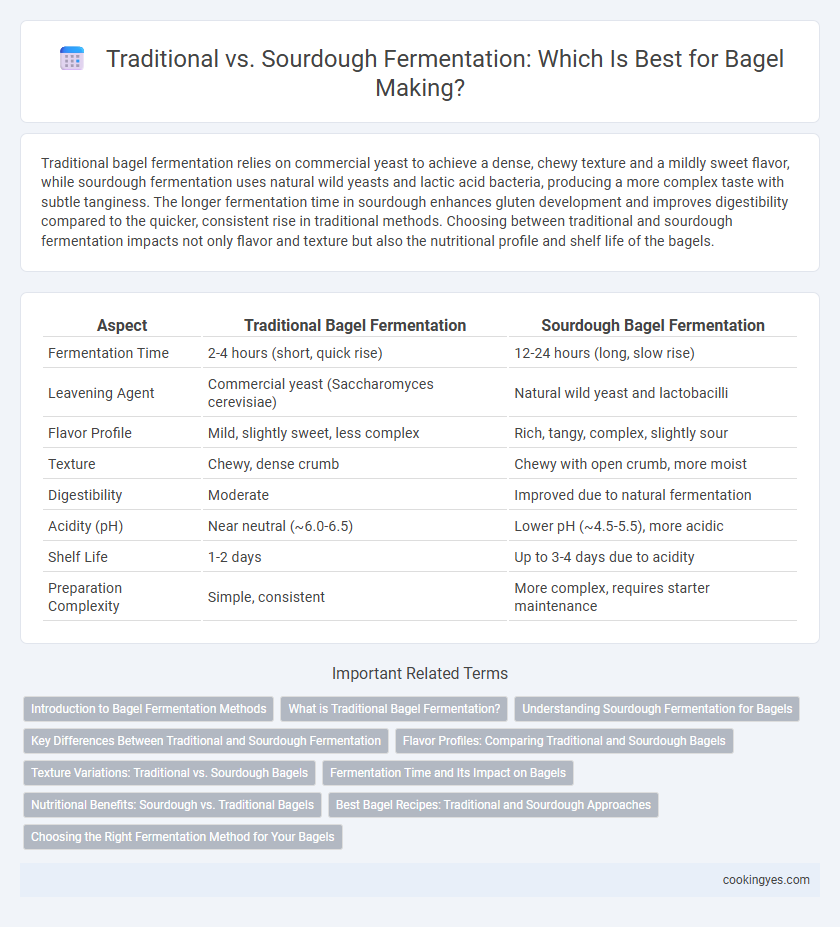Traditional bagel fermentation relies on commercial yeast to achieve a dense, chewy texture and a mildly sweet flavor, while sourdough fermentation uses natural wild yeasts and lactic acid bacteria, producing a more complex taste with subtle tanginess. The longer fermentation time in sourdough enhances gluten development and improves digestibility compared to the quicker, consistent rise in traditional methods. Choosing between traditional and sourdough fermentation impacts not only flavor and texture but also the nutritional profile and shelf life of the bagels.
Table of Comparison
| Aspect | Traditional Bagel Fermentation | Sourdough Bagel Fermentation |
|---|---|---|
| Fermentation Time | 2-4 hours (short, quick rise) | 12-24 hours (long, slow rise) |
| Leavening Agent | Commercial yeast (Saccharomyces cerevisiae) | Natural wild yeast and lactobacilli |
| Flavor Profile | Mild, slightly sweet, less complex | Rich, tangy, complex, slightly sour |
| Texture | Chewy, dense crumb | Chewy with open crumb, more moist |
| Digestibility | Moderate | Improved due to natural fermentation |
| Acidity (pH) | Near neutral (~6.0-6.5) | Lower pH (~4.5-5.5), more acidic |
| Shelf Life | 1-2 days | Up to 3-4 days due to acidity |
| Preparation Complexity | Simple, consistent | More complex, requires starter maintenance |
Introduction to Bagel Fermentation Methods
Bagel fermentation methods primarily include traditional and sourdough techniques, each influencing texture and flavor distinctly. Traditional fermentation utilizes commercial yeast for a quicker rise, producing a dense, chewy crust characteristic of classic bagels. Sourdough fermentation employs natural wild yeasts and bacteria, resulting in a tangier taste and enhanced crust complexity during a longer fermentation process.
What is Traditional Bagel Fermentation?
Traditional bagel fermentation involves using a high-gluten flour dough with a cold, slow fermentation process that develops the characteristic chewy texture and dense crumb. This method relies on commercial yeast, allowing for predictable rising times and consistent results. The dough is typically fermented for several hours or overnight to enhance flavor while maintaining the classic bagel structure.
Understanding Sourdough Fermentation for Bagels
Sourdough fermentation for bagels utilizes wild yeast and lactic acid bacteria, creating a unique tangy flavor and chewier texture compared to traditional yeast fermentation. This natural fermentation process enhances the bagel's crust development and shelf life by producing organic acids and improving gluten structure. Understanding the microbial activity in sourdough starter helps bakers control fermentation time and temperature, optimizing the bagel's taste and crumb quality.
Key Differences Between Traditional and Sourdough Fermentation
Traditional bagel fermentation relies on commercial yeast, offering a faster rise and a mild, consistent flavor, while sourdough fermentation uses wild yeast and bacteria, producing a longer fermentation that imparts a tangy taste and chewier texture. The acidity in sourdough enhances the bagel's crust development and shelf life, contrasting with the sweeter, softer crust from traditional methods. Temperature and time control vary significantly, with sourdough requiring extended proofing periods to develop its signature flavor profile.
Flavor Profiles: Comparing Traditional and Sourdough Bagels
Traditional bagels feature a mild, slightly sweet flavor with a dense, chewy texture due to yeast-based fermentation, while sourdough bagels develop a complex, tangy taste from natural lactobacillus activity and extended fermentation times. The sourdough process enhances depth and subtle acidity, contributing to a richer, more nuanced flavor profile than conventional methods. This distinction influences pairing options and overall eating experience, appealing to aficionados seeking artisanal qualities.
Texture Variations: Traditional vs. Sourdough Bagels
Traditional bagels achieve a dense, chewy texture through high-gluten flour and short fermentation with commercial yeast, creating a uniform crumb and a classic glossy crust. Sourdough bagels develop a more complex, tangy flavor and an open crumb structure due to longer fermentation and natural wild yeast, resulting in a slightly lighter texture with a crust that can be crispier and more varied. The choice between traditional and sourdough fermentation significantly influences the bagel's mouthfeel and crust characteristics.
Fermentation Time and Its Impact on Bagels
Traditional bagel fermentation typically lasts 4 to 24 hours, resulting in a denser texture and mildly sweet flavor. Sourdough fermentation extends from 12 to 48 hours, enhancing the bagel with a tangy profile and a chewier crumb due to natural wild yeast activity. Longer fermentation time in sourdough improves gluten development and complex flavor formation, making the bagel more aromatic and digestible.
Nutritional Benefits: Sourdough vs. Traditional Bagels
Sourdough bagels offer enhanced nutritional benefits due to their natural fermentation process, which increases bioavailability of minerals like magnesium and zinc and promotes gut-friendly probiotics. Traditional bagels, typically made with commercial yeast, lack these probiotic properties and may have a higher glycemic index. The extended fermentation in sourdough also reduces phytic acid, improving digestion and nutrient absorption compared to conventional bagels.
Best Bagel Recipes: Traditional and Sourdough Approaches
Traditional bagel fermentation relies on a short yeast proofing process to achieve a dense, chewy texture and distinct glossy crust, while sourdough fermentation uses natural wild yeast and lactic acid bacteria for added complexity and a tangy flavor profile. The best bagel recipes balance hydration levels, fermentation time, and boiling techniques to enhance texture and taste, with sourdough variants often requiring longer proofing periods to develop their characteristic sour note. Mastering these variables results in authentic bagels that showcase the unique benefits of both traditional and sourdough methods.
Choosing the Right Fermentation Method for Your Bagels
Traditional bagel fermentation relies on commercial yeast, resulting in a consistent rise and a slightly sweet flavor, perfect for classic, dense bagels. Sourdough fermentation uses natural wild yeast and lactic acid bacteria, developing a complex tangy flavor and chewy texture, ideal for artisan-style bagels with added depth. Selecting between traditional and sourdough methods depends on desired flavor profiles and texture, with traditional offering predictability and sourdough providing unique taste complexity.
Traditional vs sourdough for bagel fermentation Infographic

 cookingyes.com
cookingyes.com